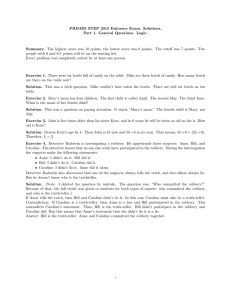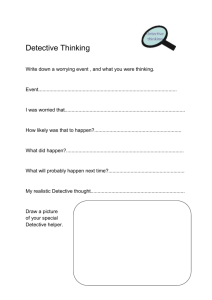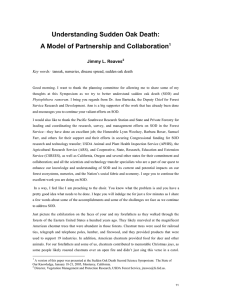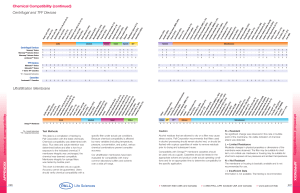PRIMES STEP 2015 Entrance Exam Part 1. General Questions. Logic. Your name:
advertisement
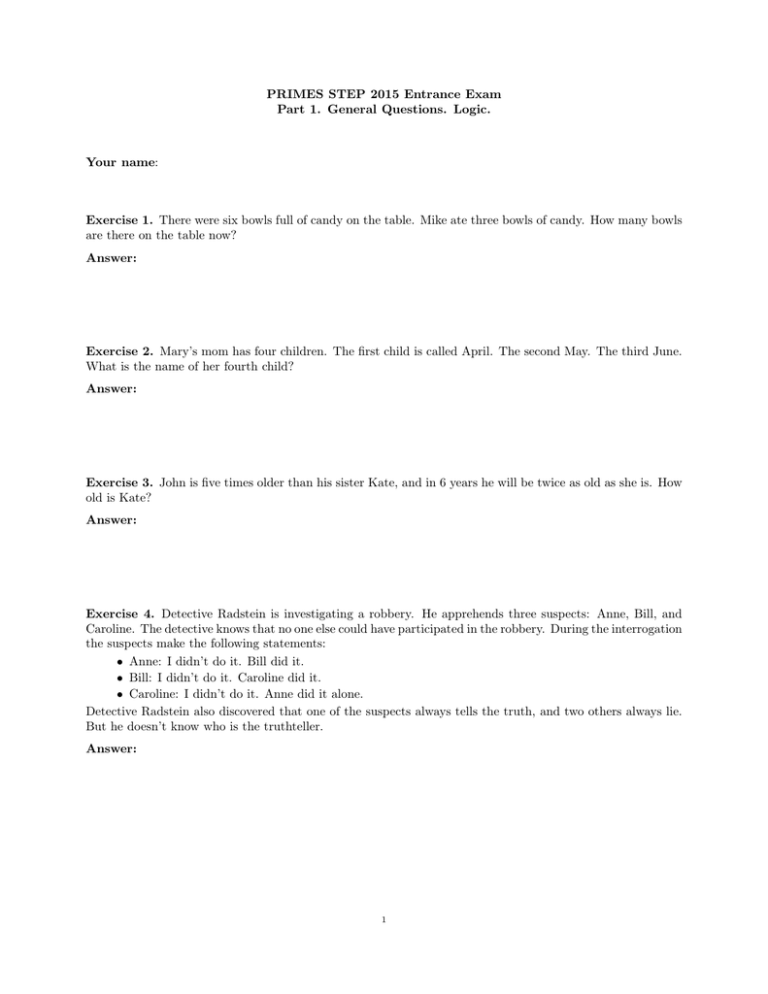
PRIMES STEP 2015 Entrance Exam Part 1. General Questions. Logic. Your name: Exercise 1. There were six bowls full of candy on the table. Mike ate three bowls of candy. How many bowls are there on the table now? Answer: Exercise 2. Mary’s mom has four children. The first child is called April. The second May. The third June. What is the name of her fourth child? Answer: Exercise 3. John is five times older than his sister Kate, and in 6 years he will be twice as old as she is. How old is Kate? Answer: Exercise 4. Detective Radstein is investigating a robbery. He apprehends three suspects: Anne, Bill, and Caroline. The detective knows that no one else could have participated in the robbery. During the interrogation the suspects make the following statements: • Anne: I didn’t do it. Bill did it. • Bill: I didn’t do it. Caroline did it. • Caroline: I didn’t do it. Anne did it alone. Detective Radstein also discovered that one of the suspects always tells the truth, and two others always lie. But he doesn’t know who is the truthteller. Answer: 1 2 Exercise 5. “John has more than a hundred books,” said Pete. “No, he has less than one hundred books,” said Ann. “He, surely, has at least one book,” said Mary. If only one statement is true, how many books does John have? Answer: Exercise 6. There are four coins lying on the table in a row. Some of the coins are fake (lighter) and other coins are real. It is known that there exist at least one fake coin and one real coin. Also, every real coin lies to the left of every fake coin. Using one weighing on a balance scale find the type of every coin on the table. Explain. Answer: Exercise 7. There are 6 glasses on the table in a row. The first three are empty, and the last three are filled with water. How can you make it so that the empty and full glasses alternate, if you are allowed to touch only one of the glasses? (You can’t push one glass with another.) Answer: Exercise 8. There are six numbers on the blackboard: 1, 2, 3, 4, 5, 6. In one move you are allowed to add 1 to any two of them. How many moves do you need to make all numbers equal each other? Explain. Answer: 3 PRIMES STEP 2015 Entrance Exam Part 2. Number Theory. Combinatorics. Algebra. Geometry. Exercise 9. Find the largest square of the form 1! + 2! + 3! + . . . + n!. Explain. Answer: Exercise 10. Let SOD(n) be the sum of the digits of n. Suppose f (n) is the result of iterating SOD many times until we get a single digit. That is, f (n) = SOD(SOD(SOD . . . (n) . . .)). Find f (22015 ). Answer: Exercise 11. I am buying six bagels. The store sells sesame, plain, and garlic bagels. In how many different ways can I buy my six bagels? Answer: Exercise 12. I have 10 students in my math club. I want to choose 2 teams of 3 people each for a math battle. In how many ways can I do it? Answer: 4 Exercise 13. Find the sum of all the coefficients of the polynomial (x2 − 4x + 1)2015 . Answer: Exercise 14. In the equation 3x2 − 3x + 1 = 0, what is the sum of the squares of the roots? Answer: Exercise 15. A triangle ABC is given. The median BX, the altitude BY , and the angle bisector BZ are drawn from the vertex B. They intersect the line AC in three different points X, Y , and Z. Which of these three points is in the middle? Explain. Answer: Exercise 16. There is an infinite wall on the plane in the form of a straight line. You have the materials to build an extra piece of wall of any shape of given length M . For some strange reason you want to build an enclosure of the maximal area and you can use the existing piece of wall. What shape should your enclosure be? Why? Answer:

